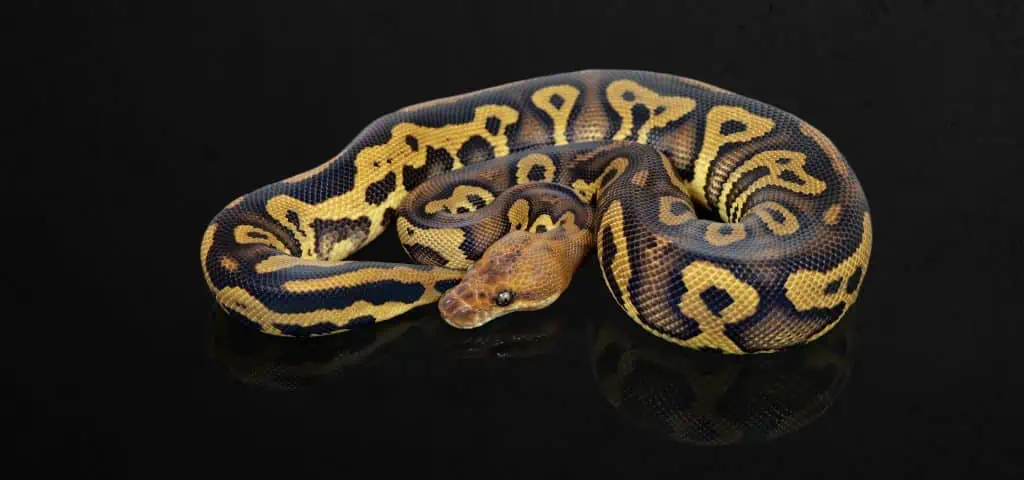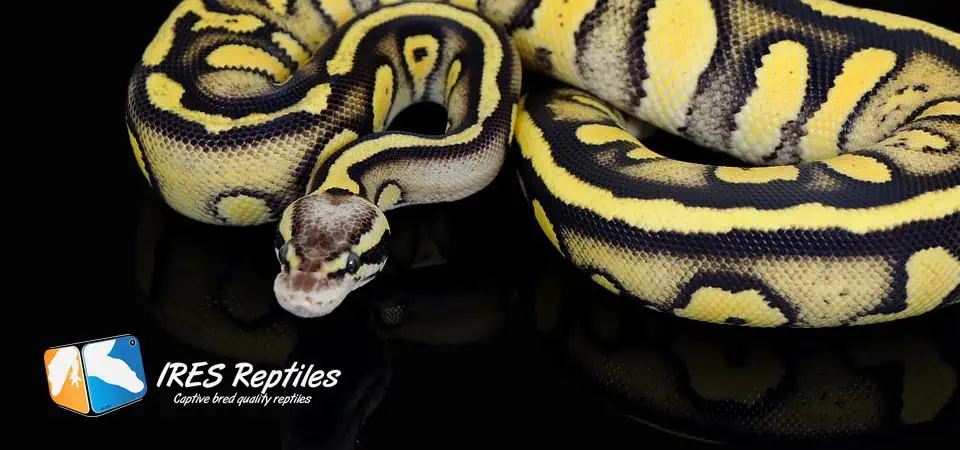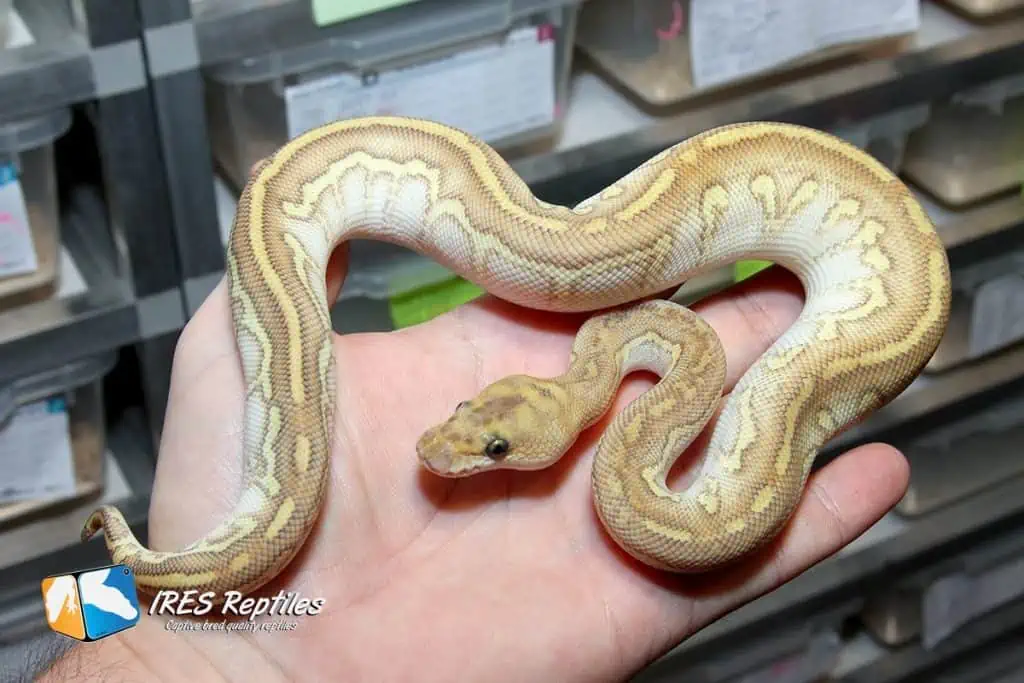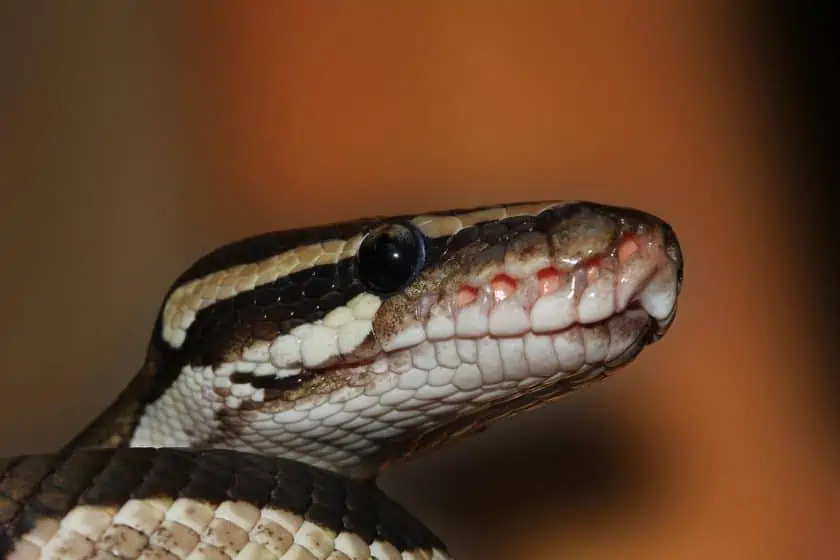Eye conditions in ball pythons are very common and can range from minor to severe. They are particularly susceptible to certain issues relating to their eyes, such as dented eyes, infections, and eye caps. Any pet owners must comprehend the potential sources of eye problems to safeguard their furry friend’s vision and wellness. In most cases, these issues are caused by stress or inadequate care practices but can also result from underlying illnesses.
Fortunately, there are preventive measures that you can take to minimize the risk of eye issues in ball pythons, such as
- Choose Appropriate Substrate
- Maintain Optimum Humidity & Temperature
- Keep the Habitat Clean
- Provide Adequate Nutrition
- Periodic Check-ups With a Veterinarian
Let’s dive into the fundamentals of common ball python eye conditions, from causes and symptoms to treatment. We will also be covering preventive measures that can help alleviate potential issues.
Snakes Eye Anatomy
Snakes possess a distinctive eye anatomy compared to other vertebrates, with their poor eyesight, lack of eyelids, and inability to blink requiring them to sleep while keeping their peepers open. Consequently, these features leave snakes particularly vulnerable to potential ocular issues due to the inadequate protection of their vision. Furthermore:
- Unlike us humans, who are trichromatic and can perceive the primary colors red, blue, and green, snakes have a dichromatic vision that allows them to distinguish between only two hues – blue and green.
- Ball pythons, naturally nocturnal creatures, possess lenses that let ultraviolet light in. This allows them to observe wavelengths outside of the visible spectrum, which is incredibly beneficial for detecting prey even at night. Thanks to their heightened sight, they can pick up on body heat from a distance, making it easier for them to hunt and survive in low-light environments.
- They possess an incredible protective adaptation: spectacles. This transparent structure is affixed to the skin and maintains a thin, moisturizing layer of fluid between it and the cornea so that the eyes remain hydrated at all times.

What Eye Conditions Can Ball Python Have?
Ball pythons may appear as if they have perfect eyesight, yet hidden beneath their scales are many potential eye problems that could affect them. While most of these conditions can be easily managed with proper care, it is important to recognize the signs and take steps to ensure your pet’s well-being.
Below I have compiled a list of the most frequent eye diseases in ball pythons, which can be either hereditary or caused by environmental factors:
Retained Spectacles
Shedding is a natural process for snakes; however, the number of times it occurs varies depending on the variety and age. During this period, spectacles – transparent structures covering their eyes – will usually be shed with their skin.
Nevertheless, eye caps or spectacles in ball pythons may not slough off as easily – an issue more likely to occur when they lack hydration or nourishment; other causes involve:
- Inadequate humidity in the terrarium
- Suboptimal husbandry
- An inadequate substrate for rubbing
- Eye or skin infection
- Improper handling (specifically just before shedding)
- Low immunity
- Trauma
- Systemic disease
- Mites infestation
Symptoms of this condition involve
- Cloudy eyes
- Empty eye holes in the shed skin
- Aggression
- Nervousness
Treatment
If this happens, delicately attempt to remove the retained with a wet cotton swab or piece of cellophane tape. Use artificial tears (hypromellose) or a hard contact lens solution to make it easier. If you don’t get rid of the debris easily and without damage, seek professional help immediately!
Cloudy Eyes
As your snake prepares to molt its skin layer, expect its eyes to become cloudy due to a milky substance used by reptiles during shedding time for quickening and simplifying this transformation! However, recognizing this transformation does not require an alarm.
Despite the fact that cloudy eyes can be a normal part of shedding, you still need to remain vigilant. If the issue persists after your snake’s shed is complete, it could actually be indicative of an underlying medical problem such as:
- Fungal infestation
- Cataracts
- Keratitis
- Blocked nasolacrimal ducts
Treatment
When faced with this situation, the only viable solution is to treat the root cause of the illness.
Eye Trauma in Snakes
Snakes are prone to injuring their eyes by furiously rubbing against the cages, resulting in lacerations and abrasions on the surface. In addition, more aggressive prey can bite them directly in the eye area. Symptoms include:
- Swelling of the eye
- Redness
- Discharge from the eye
Treatment
Though some minor damage may heal with no treatment or antibiotics, deeper wounds must be carefully stitched closed for proper healing; anything too severe could necessitate the enucleation of its eyeball altogether.
Corneal Lesions in Snakes
Injuries or infections to the eye’s outer layer can cause corneal lesions, which may appear as an ulcer or a cloudy patch. This condition is often connected with trauma or a foreign body stuck in the snake’s eye.
Treatment
To remedy corneal damage, most often, topical medication is prescribed to protect against infection and facilitate restoration.
Keratitis or Corneal Ulceration
Keratitis is a dangerous inflammation of the cornea that can have long-term effects on your ball python’s vision. This disorder may be caused by an underlying infection, improper handling or treatment, and even genetics.
Ocular problems such as redness, puffiness, cloudiness, excess discharge/tears from the eyes, or ulceration of one eye are all common signs indicating keratitis in snakes.
Treatment
Keratitis resulting from fungal sources calls for antifungal eye drops in addition to oral medications. In cases where a virus is the cause of infection, antiviral eye, and oral medication may be prescribed.
Furthermore, basic treatment, such as artificial tears, can adequately manage some viruses.
Nasolacrimal Duct Blockage
In ball pythons, the nasolacrimal duct is a tiny tube that attaches their eyes to their noses. It serves as a conduit for tears and other secretions released by the eyes and helps keep them lubricated. If something agitates the ball python’s eye, there can be overproduction or alteration of tears; however, spectacles on these snakes are connected right onto the skin, hindering excess tears from spilling out.
Consequently, if this duct becomes impaired for any number of reasons, there will be an accumulation of fluids beneath their spectacle, leading it to swell up and cause discomfort, including inflammation.
Treatment
Unfortunately, many of these blockages and infections can become resistant to treatment and grow into the periocular tissue spaces. To combat this issue:
- Fluid can be extracted by cutting through the ventral spectacle while antibiotics are applied at the same site.
- Alternatively, a new drainage route between sub spectacle space and the mouth may also be created as an effective solution.
Conjunctivitis in Snakes
Conjunctivitis, more commonly known as pink eye, is a general inflammation of the conjunctiva (the thin membrane that lines both the white area around the eyes and the inner eyelid), which can cause an abscess under a ball python’s spectacles. The primary sources of this infection are:
- Trauma
- Foreign bodies
- Poor water quality
- Vitamin A scarcity
- Chemical agents
- Pesticides
Treatment
The typical treatment for conjunctivitis involves:
- Administering topical medications to reduce swelling and
- Flushing out any debris that has caused irritation,
- Vitamin A. supplementation
In the event of sub-spectacular abscesses, a surgical procedure will be necessary in order to remove any purulent material.

Cataracts in Ball Pythons
Cataracts are a clouding of the lens inside the eye, which can cause vision impairment and blindness. In ball pythons, it can be due to age, hereditary, or caused by environmental factors such as:
- Inadequate humidity
- Poor nutrition
- Trauma
Furthermore, if systemic inflammation is left untreated, it can form a secondary cataract. If you observe milky opacity in your pet’s eyes, it is an indication of developing cataracts and should not be disregarded.
Treatment
Luckily, modern-day veterinarians can execute a procedure called phacoemulsification – a successful surgical method for treating this condition with incredibly positive results.
Uveitis
Uveitis, an inflammation of the uvea or middle layer of the eye, is a rare condition in ball pythons; however, it often manifests alongside:
- Neoplasia
- Trauma
- Necrosis of the retina
- Post-Hibernation Syndrome
- Systemic infectious disease
If left untreated, this condition can cause permanent vision loss. Symptoms of uveitis include:
- Squinting
- Pupil dilation
- Swollen eyelids
- Excessive tearing
Treatment
To treat uveitis, doctors commonly prescribe topical treatments (if applicable) as well as antibiotics. Additionally, they may suggest a combination of steroid and non-steroidal anti-inflammatory drug therapy to reduce inflammation.
Glaucoma
Glaucoma is a collection of eye diseases caused by abnormally high pressure in the fluid, known as intraocular pressure (IOP), inside the eyeball. When left untreated, this heightened IOP can harm the optic nerve – which enables the communication between our eyes and brain – potentially leading to vision loss. Symptoms of glaucoma in ball pythons include
- Redness
- Squinting
- Cloudy eyes
- Bulging of the eyes
- Swelling around the eyes
Treatment
Treatment options include medications, lasers, and, in some cases, surgery.

Preventive Measures
Taking measures to ensure your ball python’s eye health is the best way to prevent and manage any potential conditions. Here I’ve mentioned a few things you can do to reduce the risk of developing these issues:
Keep the Habitat Clean
Cleaning your ball python’s enclosure is of utmost importance. Fortunately, due to their low-frequency bathroom habits – up to two times a week at most – spot cleaning is an easy task that should be done daily; removing dirt and debris and refilling with fresh water are both essential elements.
As a pet parent, I strongly advise you to do an intensive cleanse every one or two months (or if you detect any odors). This involves removing everything from the enclosure and washing and disinfecting it all with care before allowing time for air drying. Then put everything back as soon as possible.
Maintain Optimum Humidity & Temperature
To ensure your pet python remains healthy, it is essential to maintain the ideal temperature and humidity levels within its enclosure. As these conditions help regulate their body heat, not providing them with a comfortable environment can lead to an eye infection.
For this reason, you should use a digital hygrometer to accurately measure the amount of moisture in the air and keep it between 50% – 60%. This way, you can protect your beloved reptile from potential health issues.
Choose Appropriate Substrate
Select your enclosure substrate thoughtfully to minimize the chance of anything foreign entering your pet’s eye. Cypress mulch, coconut husk, and reptile bark are all top-notch choices for ball pythons.
I advise pet owners to avoid any dry substrates that could enter their pet’s eyes. Furthermore, stay away from cedar as it is poisonous to ball pythons.
Provide Adequate Nutrition
Provide your pet with a nutritious diet tailored to their size and weight, supplying them with all the vitamins and minerals they need for their bodies to remain healthy and strong. This way, you can help ensure that your scaly companion stays well-protected against infection.
Periodic Check-ups With a Veterinarian
Regular visits to the vet can help identify any existing and potential issues that may be problematic for your ball python. I recommend you take your pet for check-ups at least once a year and whenever you notice any abnormal behaviors. This way, you can ensure your beloved reptile stays in top shape!
Take Care!
Eye conditions in ball pythons can be very concerning and cause a lot of distress, as they can lead to serious health problems if not treated properly. It is imperative to closely monitor any changes or signs of infection and take action quickly to ensure the best outcome for your reptile. Being proactive about preventive measures will go a long way in protecting it from developing any sort of eye irritation or infection.
If you have any doubts or queries regarding your ball python’s eye condition, consult a reptile expert and obtain an accurate diagnosis as soon as possible.
Have your ball pythons suffered from any of the described eye conditions? How did you manage the issue? Please share your stories in the comments section below.


